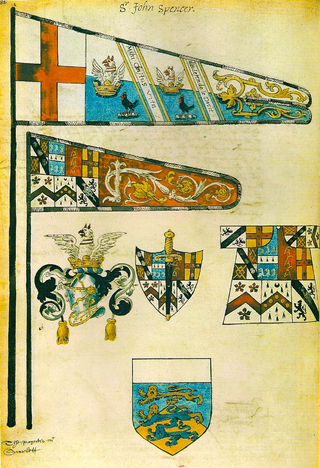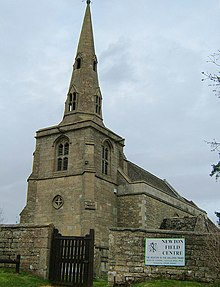
Enclosure or inclosure is a term, used in English landownership, that refers to the appropriation of "waste" or "common land" enclosing it and by doing so depriving commoners of their rights of access and privilege. Agreements to enclose land could be either through a formal or informal process. The process could normally be accomplished in three ways. First there was the creation of "closes", taken out of larger common fields by their owners. Secondly, there was enclosure by proprietors, owners who acted together, usually small farmers or squires, leading to the enclosure of whole parishes. Finally there were enclosures by Acts of Parliament.

Kettering is a market and industrial town in the North Northamptonshire unitary authority area of Northamptonshire, England. It forms a civil parish called Kettering Town. Kettering is located 67 miles (108 km) north of London and 15 miles (24 km) north-east of Northampton, west of the River Ise, a tributary of the River Nene. The name means "the place of Ketter's people ".

Francis Tresham was a member of the group of English provincial Catholics who planned the failed Gunpowder Plot of 1605, a conspiracy to assassinate King James I of England.

Monks Kirby is a village and civil parish in north-eastern Warwickshire, England. The population of the parish is 445. Monks Kirby is located around one mile east of the Fosse Way, around 8 miles north-west of Rugby, seven miles north-east of Coventry and six miles west of Lutterworth. Administratively it forms part of the borough of Rugby. One of the largest and most important villages in this part of Warwickshire in the Anglo-Saxon and later medieval period, the village continued to be a local administrative centre into the early 20th century.

A royal forest, occasionally known as a kingswood, is an area of land with different definitions in England, Wales, Scotland and Ireland. The term forest in the ordinary modern understanding refers to an area of wooded land; however, the original medieval sense was closer to the modern idea of a "preserve" – i.e. land legally set aside for specific purposes such as royal hunting – with less emphasis on its composition. There are also differing and contextual interpretations in Continental Europe derived from the Carolingian and Merovingian legal systems.

Sir Thomas Tresham was a prominent recusant Catholic landowner in Elizabethan Northamptonshire. He died two years after the accession of James VI and I.

John Manners, 1st Duke of Rutland and 9th Earl of Rutland was a British MP, and Whig politician. His divorce from his first wife caused much comment, partly because it was thought to have political implications.

Hanbury is a rural village in Worcestershire, England near Droitwich Spa and the M5 motorway. The population of Hanbury has remained around 1,000 since the early 19th century, and apart from farming and the popular Jinney Ring Craft Centre there is little economic activity, as the parish is lived in mainly by those who commute to the nearby towns of Bromsgrove, Redditch, Droitwich and Worcester, and the slightly more distant areas of Birmingham and the Black Country.

Deene Park, the seat of the Brudenell family since 1514, is a country manor located 5 miles north-east of Corby in the county of Northamptonshire, England. The hall itself is a Grade I listed building dating back to the 14th century which has been modified several times since then to create the current structure.

Newton, sometimes called Newton in the Willows, is a small village and former civil parish, now in the parish of Newton and Little Oakley, in the North Northamptonshire district, in the ceremonial county of Northamptonshire, England. The village is in the Ise valley. Newton and Little Oakley had a population at the 2001 census of 147, decreasing to 126 at the 2011 Census. It has a combined parish council with Geddington.

Cotesbach is a village and civil parish in the Harborough district of Leicestershire, England. The nearest town is Lutterworth, about 1+1⁄2 miles (2.4 km) to the north. Rugby is 6 miles south of the parish. The River Swift flows through the parish, to the north of the village. The parish is located near the M1, M6 and A5, with the main settlement just off the A426 Rugby Road, which was built to bypass the village. Until the year 2000 the village had a small post-office, operated inside the porch of a resident's cottage.
The Western Rising was a series of riots which took place during 1626–1632 in Gillingham Forest on the Wiltshire-Dorset border, Braydon Forest in Wiltshire, and the Forest of Dean, Gloucestershire in response to disafforestation of royal forests, sale of royal lands and enclosure of property by the new owners. Disafforestation is a change in legal status that allows the land to be sold normally, rather than being preserved as a forest. Enclosure takes the land out of common use, denying access to non-owners who had previously used it.
Derbyshire County Cricket Club in 1981 represents cricket season when the English club Derbyshire had been playing for one hundred and ten years. It was the season when they won National Westminster Bank Trophy. They won ten matches in the John Player League to finish fourth. In the County Championship, they won four matches to finish twelfth in their seventy-seventh season in the Championship. They were eliminated at group level in the Benson & Hedges Cup.

Sir Robert Throckmorton, KG, of Coughton Court in Warwickshire, was a Member of Parliament and a distinguished English courtier. His public career was impeded by remaining a Roman Catholic.
Derbyshire County Cricket Club in 1983 was the cricket season when the English club Derbyshire had been playing for one hundred and twelve years. In the County Championship, they won seven matches to finish ninth in their seventy ninth season in the Championship. They came sixth in the John Player Special League. They did not progress from the group in the Benson & Hedges Cup and reached round two in the National Westminster Bank Trophy.
Leicester Forest was a Royal Forest that existed to the West of Leicester.
Walter Blith (1605–1654) was an English writer on husbandry and an official under the Commonwealth. His books promoted improvements in techniques, but were suppressed after the 1660 Restoration.

Sir John Spencer was an English nobleman, politician, landowner, sheriff, knight, and MP from the Spencer family.

Kirroughtree House is the heritage-listed mansion house of the Kirroughtree estate. It occupies a prominent position 1 mile (1.6 km) northeast of the town of Newton Stewart in the Galloway region of southwest Scotland. The main access is from the A712 close to its junction with the A75. Kirroughtree House was the family seat of the Heron family from the 14th or the 15th century until the 1880s. The mansion house is now a luxury hotel. While remnants of an older house have been found in a blocked-off cellar, the current house dates to 1719 with extensions to the northeast added in the 19th and early 20th century. The house has connections with both James Boswell and Robert Burns, each of whom stayed at Kirroughtree House as guests in the later 18th century.
Cutts Barton (1706–1780) D.D. was an English cleric, Dean of Bristol from 1763 to 1780.














